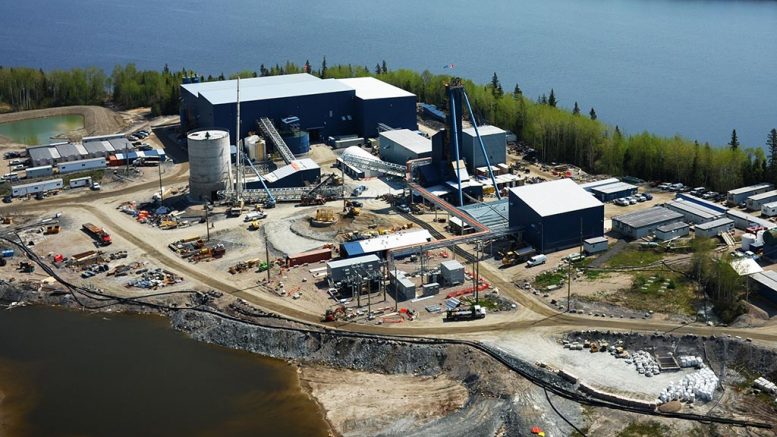Rubicon Minerals (TSX: RMX; US-OTC: RBYCF) has boosted the measured and indicated resource by 113% and the inferred resource by 80% at its Phoenix gold project in Red Lake, Ont., after reinterpreting its geological model — a change which may support larger-scale underground mining.
The updated resource incorporates another 23,500 metres of oriented drilling done in 2017 (out of a total 28,500 metres), as well as the relogging of 10,000 metres of historical core. The calculation includes 483,303 metres of drilling from February 2008 to November 2017.
The project has 1.4 million measured and indicated tonnes grading 6.37 grams gold per tonne for 281,000 oz. gold, as well as 3.9 million inferred tonnes at 6 grams gold for 749,000 oz. gold — all at a 3 gram gold cut-off grade. The estimate does not, however, contain data from 5,000 metres of drilling done in late 2017. Rubicon says it will incorporate this data and more into an updated resource estimate in 2019.
The company had first interpreted its F2 deposit in 2013 via east-to-west surface drilling, perpendicular to the main mineralized zone. It completed a preliminary economic assessment, and, skipping the feasibility phase, was test mining by 2015. However, Rubicon soon had trouble reconciling grades. With the mine now built, the company decided to analyze the deposit from underground.

George Ogilvie
President and CEO, Rubicon Minerals
“They took a look around and saw that, structurally, it’s a lot more complex than what they had modelled several years prior,” Rubicon president and CEO George Ogilvie says in an interview at the company’s downtown Toronto office.
In June 2015, the company announced it poured first gold, but by year-end all underground and milling activities were suspended, and Rubicon’s share price plunged as grade reconciliation problems emerged. Ogilvie took over as CEO in December 2016 after Michael Lalonde stepped down in October 2015.
Ogilvie was CEO of Kirkland Lake Gold (TSX: KL; US-OTC: KLGDF) from 2013 to 2016, and before that CEO of Rambler Metals and Mining (TSXV: RAB; LON: RMM) for over seven years. When Rubicon restructured, Ogilvie put $650,000 of his own money into the company at an average weighted price of $1.37 per share.
“I want this thing to succeed as well,” Ogilvie says. “I’ve got some real skin in the game, which I think is important.”
He says the company found cross-cutting structures running east to west. Because the surface drilling ran parallel to these structures, it missed them. At the time, the company didn’t know if they were regional events that went on for several kilometres, or localized within the high-titanium basalts. The company now knows these east-to-west veins are high grade, and anywhere from two to 20 metres wide, although with very little strike length. Thanks to oriented drilling, it also knows it has longer north-to-south veins and northwest-to-southeast veins.
The company thought of its project as a Riedel shear system. Although Rubicon came up with the idea in late 2017, it would spend four months validating it through hard data coming out of the mine.
“That was the prudent approach, given the history of Rubicon and the challenges that we’ve had,” Ogilvie says.
The new interpretation shows better continuity than the company’s 2016 model — continuity that may allow for bulk underground mining methods, instead of the highly targeted approach the company had previously considered. The company aims to complete a 25,000- to 30,000-tonne bulk sample in mid-2018, which the company hopes will validate its current resource.
This year, the company plans to infill drill another 20,000 metres at its main F2 gold deposit. At year-end it may drop holes into its McFinley zone, 600 metres from F2, on the other side of the existing shaft. The company has six other targets within 2 km of Phoenix, all potentially accessible from underground, but this will not become a priority until it has explored F2 and McFinley.
A 2015 photo of surface facilities at Rubicon Minerals’ Phoenix gold project in Ontario. Credit: Rubicon Minerals.
The company also has what Ogilvie calls an “extensive” land package at Red Lake. It owns 200 sq. km of real estate, which is equal to 40% of all claims at Red Lake — second only to Goldcorp (TSX: G; NYSE: GG). In addition, 80% of those claims butt up against one another.
“Our primary goal is to get Phoenix moving back into commercial production, but we shouldn’t forget about these other opportunities,” Ogilvie says. “If we can get Phoenix up and running here in the next two to three years and into commercial production, this company has got the opportunity to significantly increase the life-of-mine.”
If it gets favourable drill results and can increase its resource, the company wants to undertake a feasibility study in the first half of 2019. Given the history of the project, Ogilvie says it is “absolutely important” to complete a feasibility study before progressing the project, to build trust with the company’s shareholders and potential investors. It has the cash to get to feasibility, but it would need more financing.
“At the end of the year if the resource grows but it doesn’t grow enough, we may make the decision not to do a feasibility study — but that doesn’t mean the project is dead,” Ogilvie says. “It could just be a function that we need to continue drilling because we need to get more measured and indicated resources.
“If we want to justify refinancing the project and taking it to commercial production, we certainly want to make sure we’re doing things the proper way and dotting the i’s and crossing the t’s.”
Shares of Rubicon are valued at $1.25, within a 52-week range of $1.13 to $1.88.
The company has an $81-million market capitalization.


Be the first to comment on "Rubicon adds to resource at Phoenix in Red Lake"